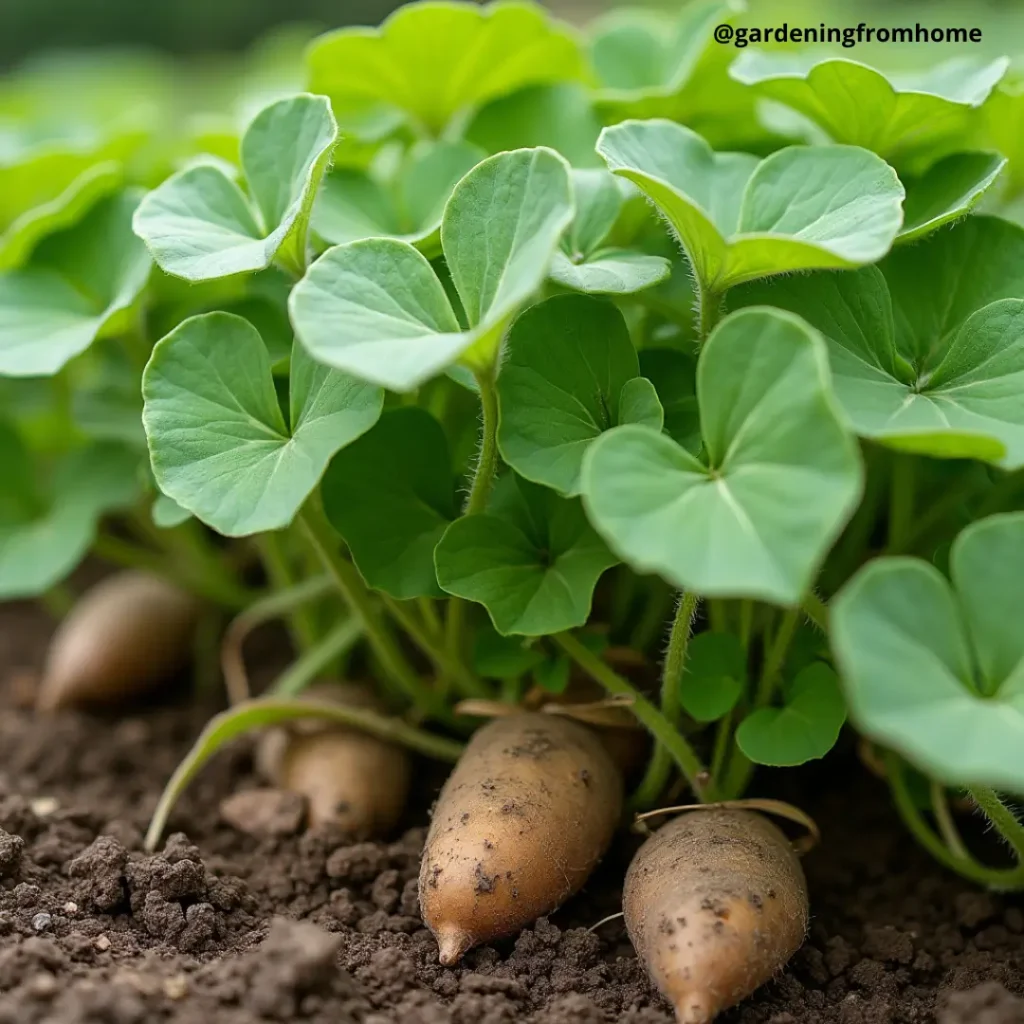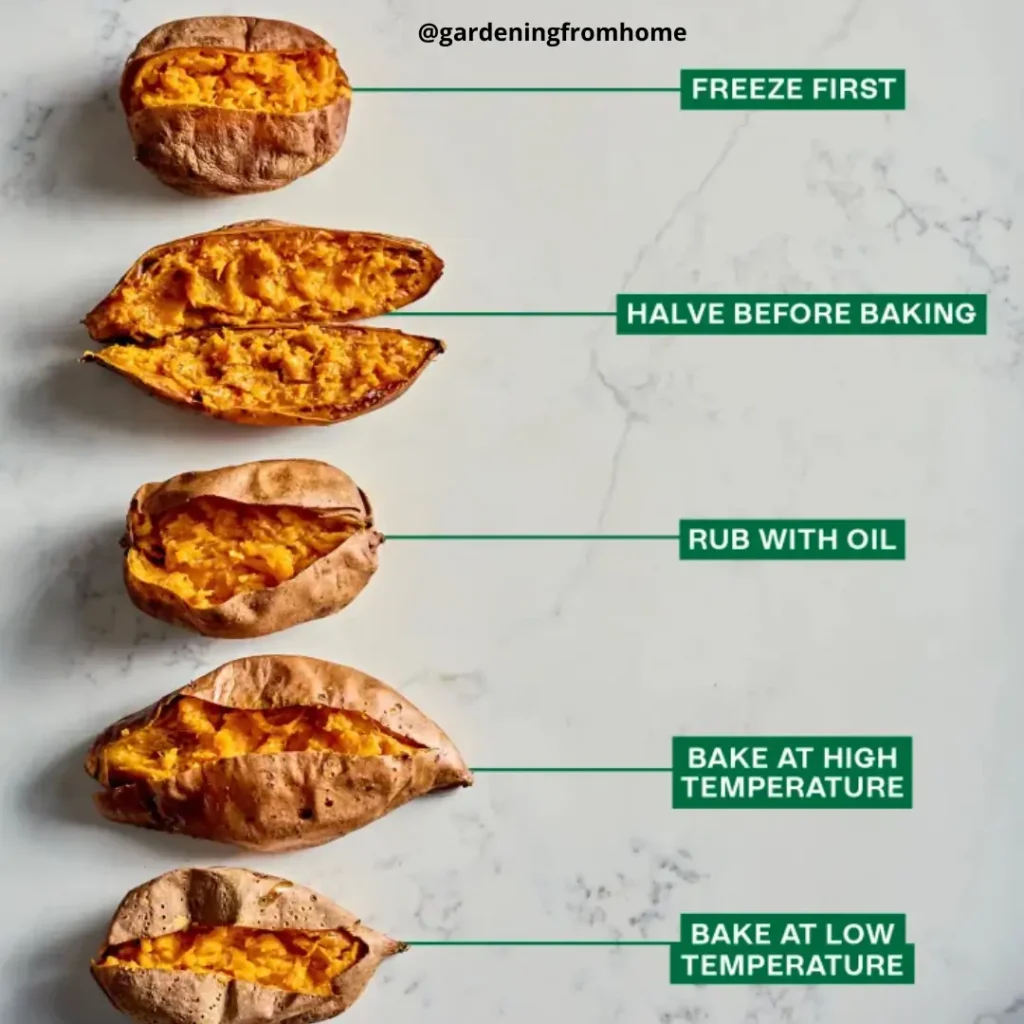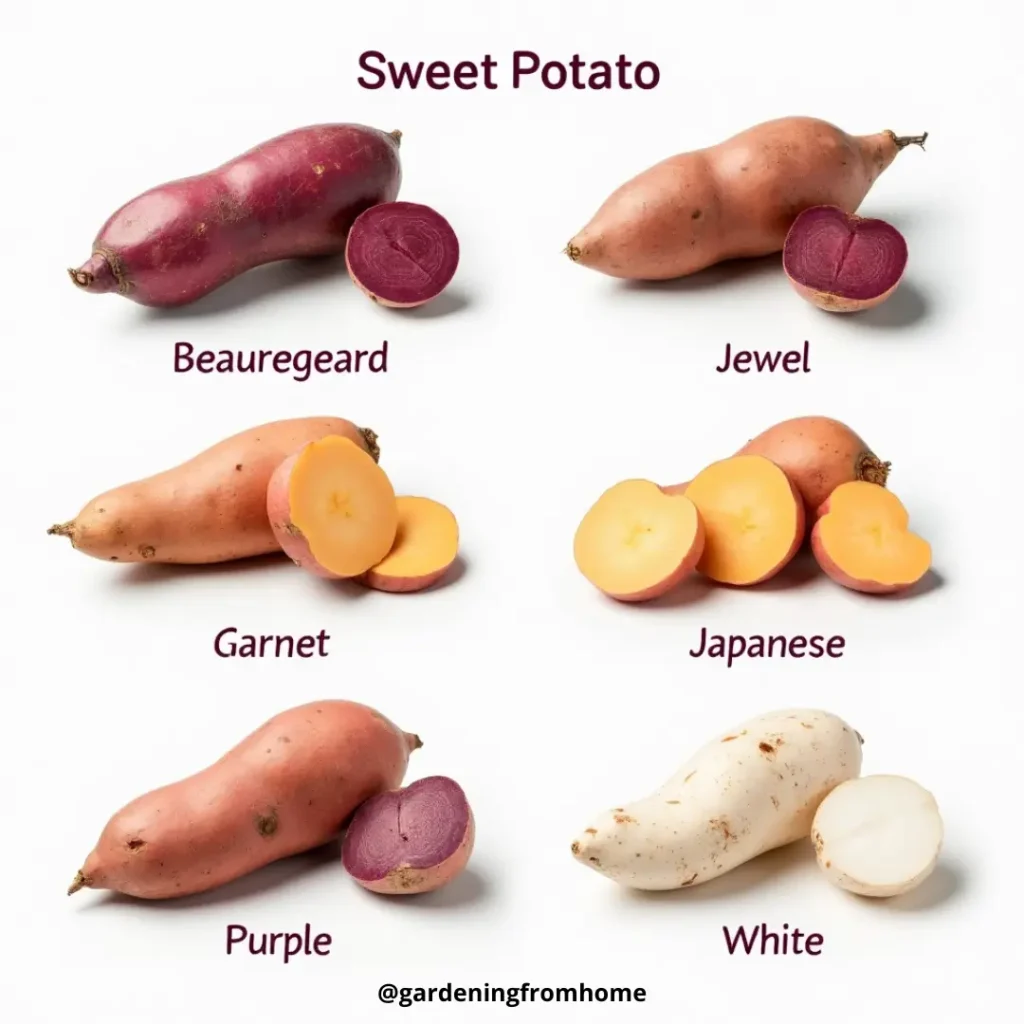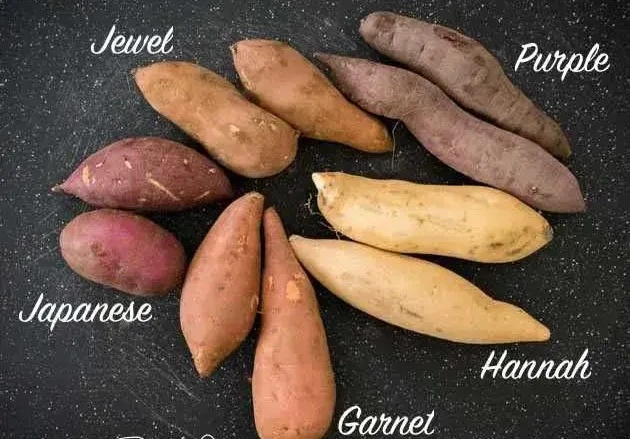6 Amazing Types of Sweet Potatoes with Growing Tips and Tried Recipes
Introduction :
Sweet potatoes are more than just a holiday favorite. Their vibrant colors, nutritional power, and culinary flexibility make them a staple in kitchens around the world. From the deep orange Beauregard to the creamy white Japanese Satsumaimo, each variety brings something different to the table.
Understanding the different types of sweet potatoes helps gardeners, cooks, and health-conscious individuals choose the best ones for their needs. In this guide, we’ll explore sweet potato types, compare white sweet potato vs orange sweet potato, and help you understand the difference between sweet potatoes and yams.
Table of Contents
🌿 What Is a Sweet Potato ?
Despite their name, sweet potatoes are not actually related to regular potatoes. Sweet potatoes belong to the morning glory family (Convolvulaceae), while common potatoes come from the nightshade family. Sweet potatoes are tuberous roots, not stem tubers like white potatoes.
The plant, scientifically known as Ipomoea batatas, grows best in warm climates. Native to Central and South America, it has been cultivated for thousands of years.
These roots are known for their naturally sweet taste, which intensifies when cooked. They come in various shapes, colors, and textures making them one of the most versatile crops you can grow or cook with.

🍯 How Do They Become Sweet ?
Sweet potatoes get sweeter when cooked, thanks to natural enzymes that break down starches into sugar. The key enzyme, amylase, becomes more active at certain temperatures, especially during baking or slow roasting.
As sweet potatoes cook, especially at temperatures around 170–190°F (77–88°C), their starches convert into maltose, giving them their signature sweetness. This process explains why roasted sweet potatoes often taste much sweeter than steamed or boiled ones.
Varieties differ in sweetness too. Japanese and purple types are usually milder and drier, while orange varieties like Garnet and Beauregard are moist and sugary.

🍠 What’s the Difference Between Sweet Potatoes and Yams ?
It’s a common mix-up, but sweet potatoes and yams are not the same. In fact, most “yams” sold in U.S. supermarkets are actually sweet potatoes.
- Yams are starchy tubers native to Africa and Asia, belonging to the Dioscorea family. They have rough, bark-like skin and are typically white or purple inside, with a dry texture.
- Sweet potatoes are smoother-skinned, with orange, white, or purple flesh. They’re sweeter, moister, and more commonly used in Western recipes.
The USDA allowed the term “yam” to describe orange-fleshed sweet potatoes decades ago, mainly for marketing. So if you’re buying “yams” in the store, you’re probably just getting a different sweet potato type.

🍽 Common Varieties with Details of the Best Ones
Here are the most popular sweet potato varieties, with details on flavor, texture, and best use:
1. Beauregard ;
- Color: Deep orange flesh, reddish skin
- Flavor: Very sweet
- Texture: Moist
- Use: Roasting, casseroles, baking
- Note: Most common variety in the U.S.
2. Jewel :
- Color: Orange flesh, copper skin
- Flavor: Mild and sweet
- Texture: Creamy
- Use: Baking, mashing
3. Garnet (Red Sweet Potato) :
- Color: Orange-red skin, dark orange flesh
- Flavor: Sweet and rich
- Texture: Moist
- Use: Roasting, desserts
4. Japanese Sweet Potato (Satsumaimo) :
- Color: Purple-red skin, white flesh
- Flavor: Chestnut-like sweetness
- Texture: Dry
- Use: Baking, steaming
5. Okinawan (Purple Sweet Potato) :
- Color: Beige skin, deep purple flesh
- Flavor: Mild and earthy
- Texture: Dense
- Use: Steamed or baked, vibrant desserts
6. White Sweet Potato (Hannah or O’Henry) :
- Color: Light tan skin, white to cream flesh
- Flavor: Less sweet
- Texture: Dry and firm
- Use: Mashed, soups, fries

Selecting and Storing :
Choose sweet potatoes that are:
- Firm to the touch
- Free of bruises or soft spots
- Smooth-skinned and dry
Avoid those with cracks, sprouts, or mold. Store them in a cool, dry, and dark place—not in the fridge, which can change their texture and taste.
Curing sweet potatoes (allowing them to rest in a warm, humid area for 7–10 days after harvest) helps convert starches into sugars and improves flavor.
Stored correctly, they can last 2–3 months.
💪 Health Benefits :
Sweet potatoes are a nutritional powerhouse:
- High in vitamin A (from beta-carotene)
- Rich in vitamin C, B6, and potassium
- Good source of fiber, especially with skin on
- Low on the glycemic index (especially boiled)
Their antioxidants help reduce inflammation and promote gut health. Purple varieties contain anthocyanins, which support brain and heart function.
White sweet potatoes are great for those monitoring blood sugar. They offer a lower sweetness level while still being nutritious.
🍲 Recipes :
Sweet potatoes are perfect for both savory and sweet dishes. Their natural sweetness and diverse textures make them a favorite in many cuisines. Below are two ways to explore them: some popular go-to dishes and a variety-specific recipe guide.
1. Favorite Sweet Potato Dishes :
Here are some easy and delicious ways to cook sweet potatoes at home:
- Baked Sweet Potato Fries
Crispy edges, tender inside—seasoned with paprika and garlic. - Sweet Potato Pie
A Southern classic, creamy and sweet with cinnamon and nutmeg. - Mashed Japanese Sweet Potatoes
Smooth, buttery texture, perfect with a touch of miso or butter. - Purple Sweet Potato Smoothie
Colorful and packed with nutrients—blend with banana and almond milk. - Sweet Potato Tacos
Roasted cubes served with black beans, avocado, and lime crema in tortillas.
Sweet potatoes are also great in soups, stews, muffins, breakfast bowls, and even pancakes. Their versatility makes them an easy addition to almost any meal.
2. Best Recipes by Sweet Potato Type :
| Sweet Potato Type | Best Recipes |
|---|---|
| Beauregard (Orange) | Sweet potato pie, roasted wedges, casseroles |
| Jewel (Orange) | Mashed sweet potatoes, sweet potato muffins, oven-baked fries |
| Garnet / Red Sweet Potato | Caramelized sweet potato bowls, roasted garnet tacos, spicy curry |
| Japanese (White Flesh) | Baked slices with miso glaze, tempura, mashed with sesame oil |
| Purple / Okinawan | Smoothies, mochi, steamed purple mash, baked donuts |
| White Sweet Potato | Garlic roasted white sweet potatoes, creamy soups, air fryer fries |
Each sweet potato type brings something unique to the kitchen. For instance, Garnet’s moist flesh works beautifully in desserts and rich side dishes, while Japanese and White varieties, with their firmer texture, hold up well in roasting or air-frying.

Conclusion :
There are many types of sweet potatoes, each with their own taste, color, and use in the kitchen. Whether you’re growing them at home, experimenting with new recipes, or looking for the healthiest option, there’s a variety to match every need.
By understanding the differences in sweet potato types, including comparisons like red sweet potato vs sweet potato and white sweet potato vs orange sweet potato, you’ll make better choices in the garden and the kitchen.
Don’t forget gardening from home is a great way to enjoy fresh sweet potatoes while exploring different sweet potato varieties naturally.
FaQs :
- 1. What are the main types of sweet potatoes?
There are several popular sweet potato types, but the most common include Beauregard, Jewel, Garnet (Red), Japanese (White), Purple (Okinawan), and White Sweet Potatoes. Each has its own flavor, texture, and best use in recipes.
2. What’s the difference between white sweet potatoes and orange sweet potatoes?
White sweet potatoes have a firmer texture and milder flavor, with less sweetness. They’re great for savory dishes and air frying. Orange sweet potatoes like Beauregard are moister and sweeter, making them perfect for pies, casseroles, and baking.
3. How many types of sweet potatoes are there globally?
There are over 400 varieties of sweet potatoes worldwide, though only a handful are commonly found in supermarkets. The major types differ in color (orange, white, purple), flavor, sweetness, and moisture content.
4. Are sweet potatoes and yams the same thing?
No, they’re not. True yams are a completely different root vegetable with rough, bark-like skin and starchy white flesh. In the U.S., many orange-fleshed sweet potatoes are labeled as yams, but they are actually sweet potatoes.
5. Which sweet potato is healthiest?
All sweet potatoes are nutritious, but purple sweet potatoes stand out for their high levels of antioxidants (anthocyanins). Orange types are rich in beta-carotene, which supports vision and immunity.
6. Can I grow sweet potatoes at home?
Yes! Sweet potatoes are easy to grow at home, especially in warm climates. Start with slips (sprouted pieces from a sweet potato), plant them in loose soil, and give them sun and space to vine. Most types take 90–120 days to mature.
7. How should I store sweet potatoes?
Store them in a cool, dark, and well-ventilated place—like a pantry or root cellar. Avoid refrigerating them, as cold temperatures can change their texture. Properly cured sweet potatoes can last 2–3 months.
8. What are some easy recipes for beginners?
Start with baked sweet potato fries, mashed Japanese sweet potatoes, or a simple sweet potato smoothie. Roasting or baking are easy methods that bring out their natural sweetness with minimal effort.

